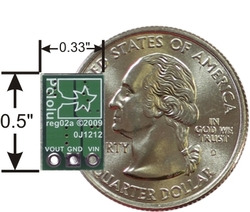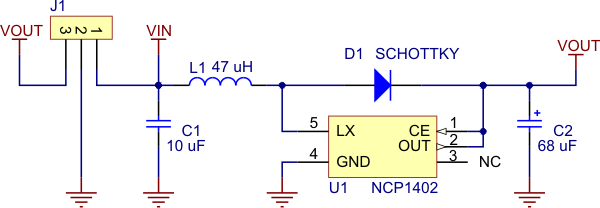This extremely compact boost regulator generates 5V from voltages as low as 0.8V and delivers up to 200mA, making it perfect for powering small 5V electronics projects from 1 to 3 NiMH, NiCd, or alkaline cells or from a single lithium-ion cell.

Overview
This tiny boost switching regulator is based on the NCP1402 boost regulator IC. Its small dimensions of just 0.33"x0.5" (8.4x12.7mm) and a startup voltage of down to 0.8V make it easy to build 5V circuits that are powered by lower battery voltages. The available output current and output voltage ripple depend on the input voltage. With a 0.8V input, approximately 5mA are available before the output voltage begins dropping. The full 200mA output can be realized from input voltages over approximately 2.7V. With low input voltages, the output voltage ripple is under 40mV peak-to-peak; close to 5V, the output ripple quickly climbs to 150mV peak-to-peak. Therefore, adding capacitance from the output to ground is recommended for noise-sensitive applications with input voltages close to 5V.
Some example applications include:
- Powering 5V systems from lower-voltage batteries.
- Powering 5V subsystems (e.g. sensors) in lower-voltage (e.g. 3.3V) systems.
Using the Boost Regulator
The boost regulator has just three connections: the input voltage, ground, and the output voltage. These three connections are labeled on the back side of the PCB, and they are arranged with a 0.1" spacing along the edge of the board for compatibility with standardsolderless breadboardsand perfboards andconnectorsthat use a 0.1" grid. You can solder wires directly to the board or solder in either the 3x1straight male header stripor the 3x1right-angle male header stripthat is included.
Feature summary
- operating voltage: 0.8V to 5.0V
- 5.0V output with 2.5% accuracy
- small size: 8.4x12.7x3.8mm (0.33"x0.50"x0.15")
- weight without header pins: 0.6g (0.02oz)
 |
| 5V boost regulator NCP1402 schematic diagram. |
No recommended products at the moment.
No recommended products at the moment.